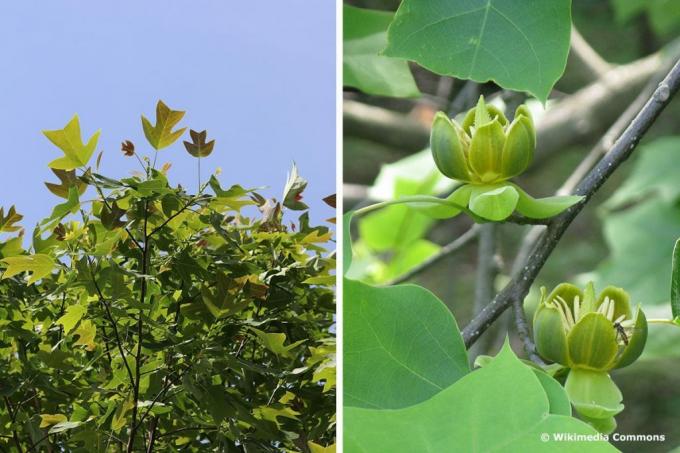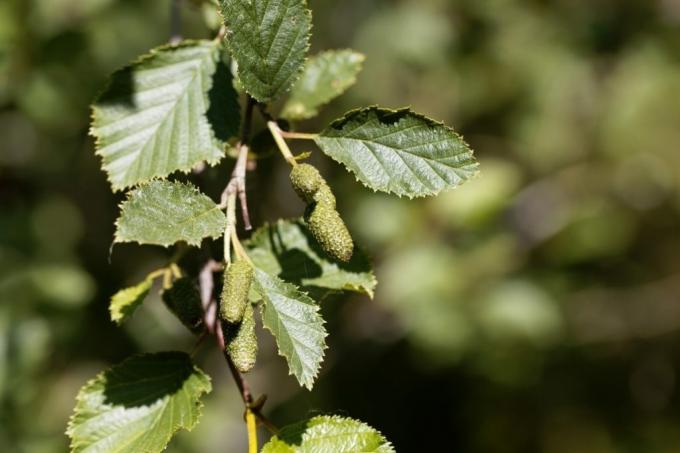
table of contents
- Cones
- Chinese tulip tree (Liriodendron chinense)
- Gray alder (Alnus incana)
- Green Alder (Alnus viridis)
- Black Alder (Alnus glutinosa)
- frequently asked Questions
Everyone knows fir, pine and spruce cones. But not only conifers form cone-shaped inflorescences. We present deciduous trees that form cones and their special features.
In a nutshell
- Cones are a fruit shape
- less often in deciduous trees than in conifers
- Cones contain seeds
- popular as decoration and in the aquarium hobby
Cones
Conifers often produce cones. Are there also deciduous trees that develop cones? We investigated this question and put together cone-forming varieties. Cones on deciduous trees are lignified inflorescences. The seeds are located behind the cone scales, which are initially still soft. It is worth taking a closer look at the structure. The spiral arrangement of the tenon scales around the tenon spindle follows a fixed construction plan.
Chinese tulip tree (Liriodendron chinense)
The Chinese tulip tree enchants with its exotic looking flowers. The deciduous tree, which comes from Asia, can be seen more and more frequently in German gardens and parks.

- Family: Magnolia family (Magnoliaceae)
- Occurrence: in Germany widespread in parks and gardens
- Height: 10 to 15 meters
- Growth habit: tree
- Leaves: 10 to 15 centimeters long, four times lobed, glossy green upper surface, light green lower surface, initially waxy
- Flowers: hermaphrodite, bell-shaped, yellow petals with a greenish base, thick stamens
- Flowering period: April to May
- Cones: 10 centimeters long, conical, consists of spirally assembled nuts, resembles a conifer cone
- Fruit ripening: September to October
Note: Chinese tulip trees are excellent bee pastures. The first flowers appear after fifteen years. Then a small tulip tree is enough to produce one to two kilograms of honey.
Gray alder (Alnus incana)
The gray alder is widespread in Central Europe. The deciduous tree even grows at high altitudes in the Alps.

- Family: Birch family (Betulaceae)
- Occurrence: everywhere in Germany
- Height: 10 to 25 meters
- Growth habit: tree or high shrub
- Leaves: 4 to 10 mm long, elliptical, green upper side, blue-gray lower side
- female flowers: inconspicuous
- male flowers: drooping catkins
- Flowering period: March to April
- Cones: egg-shaped, woody, 13 to 16 millimeters long, 10 millimeters wide, contain laterally winged nuts
- Fruit ripening: September to October
Green Alder (Alnus viridis)
The green alder is a widespread, small deciduous tree or shrub with cones. It is primarily at home in the German low mountain ranges.

- Family: Birch family (Betulaceae)
- Occurrence: at high altitudes in the mountains
- Height: 10 to 25 meters
- Growth habit: tree or high shrub
- Leaves: 10 to 20 millimeters long, elliptical, upper side green, underside light green, shiny
- female flowers: inconspicuous, overwinter in the buds
- male flowers: limp, drooping catkins
- Flowering period: April to May
- Cones: egg-shaped, woody, 10 to 13 millimeters long, 7 millimeters wide, contain small winged nuts
- Fruit ripening: October to November
Black Alder (Alnus glutinosa)
Three different species of the black alder are native to Germany. They grow on moist clay and gravel soils.

- Family: Birch family (Betulaceae)
- Occurrence: in damp locations, near water
- Height: 10 to 25 meters
- Growth habit: tree, richly branched
- Leaves: 10 to 20 millimeters long, roundish, green upper side, light green underside, initially sticky
- female flowers: inconspicuous,
- male flowers: limp, drooping catkins, developed in the previous year, overwintering naked
- Flowering period: March to April
- Cones: egg-shaped, woody, 15 to 18 millimeters long, 10 to 12 millimeters wide, contain laterally winged nuts
- Fruit ripening: September to October
Note: The black alder can live up to 100 years.
frequently asked Questions
The cones are used for reproduction. The seeds are located behind the cone scales.
Just like the cones of the conifers, those of the deciduous trees have a high decorative value. They are suitable for the design of flower arrangements and Christmas decorations. Black alder cones are collected by aquarists and used in ornamental fish farming because of their germ-inhibiting effect.
The cone-shaped fruits of the alder contain many small nuts, the seeds. Only after winter, when the alder cones have become firm and woody, are they spread by wind and water and bring about new life.
